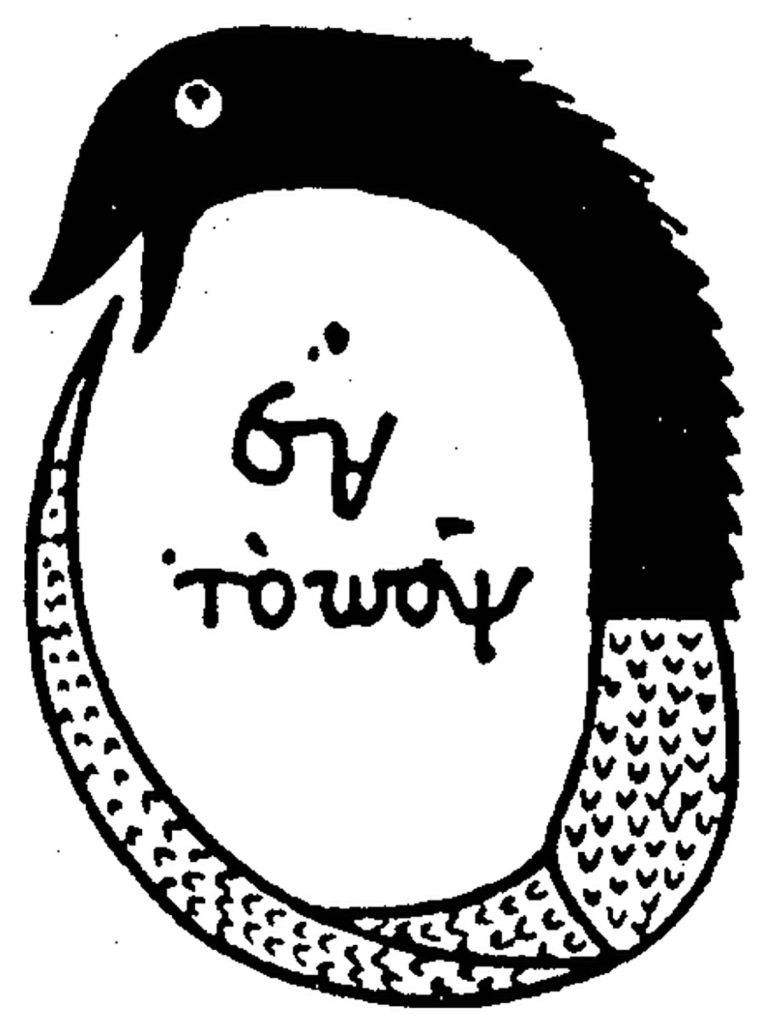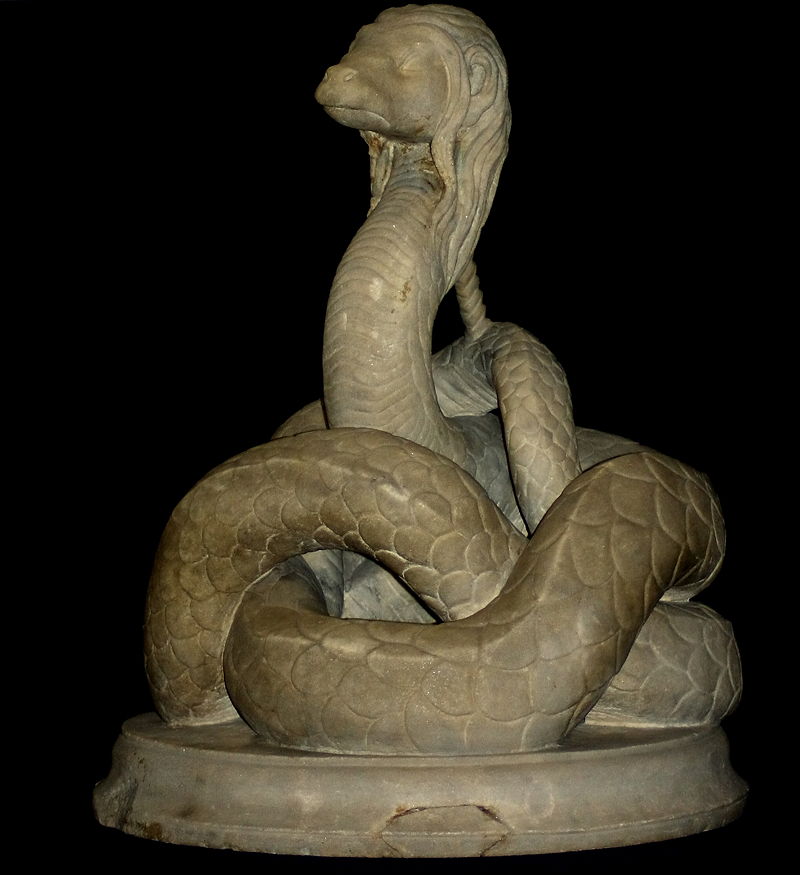Make Paradise Great Again; or, the Most Subtle of the Beasts
Where paradises fall, so shall serpents be found: Snakes as awkward symbols of American defiance.
In our winter of authoritarianism, no artist encapsulates the tackiness of evil quite as much as Mormon fabulist painter Jon McNaughton, whose Manichean politics are so concrete you can see the cracks in the pavement. Liberals? Bad! Democrats? Bad, Bad! Barack Obama? Bad, Bad, Bad! Donald Trump? Good! McNaughton’s paintings include Via Dolorosa, which shows a contemporary business man playing the role of Simon of Cyrene (Karl Marx is in the crowd); Angel of Liberty – The Vision of George Washington, which presents a celestial being, as if from Revelation, brandishing a sword and an American flag over a burning capital; and most miraculous, All-American Trump, which depicts its svelte subject in a red jersey and old timey leather football helmet running into the endzone like he’s Knut Rockne.
McNaughton’s most famous painting, 2010’s The Forgotten Man, depicts the White House in an eerie twilight with a gathering of the first 43 presidents, including an argumentative Abraham Lincoln and a grimly constipated Ronald Reagan, behind the dejected titular (white) everyman who looks like he just missed a Gander Mountain sale. Standing apart is a haughty Obama, his foot on the Constitution, with an angry James Madison gesturing as if toilet paper was stuck on the 44th president’s blucher. Yet few of McNaughton’s stunningly unsubtle images quite capture the myopic hypocrisy of the religious right as fully as his addendum to The Forgotten Man, his 2017 piece entitled You are Not Forgotten.
Sad Gander Mountain guy is back, but now he’s no longer sad! He has a partner, a pretty (white) woman who is dressed in a similarly rustic manner, and the panoply of presidents has been replaced with a heroic assemblage of (mostly white) first responders, including cops, soldiers, bikers (?!), and one saluting marine. Gander Mountain guy tends to a fragile flower growing through the cracks of Washington DC, as parched and barren as the Great Salt Lake. Trump, with hand outstretched in benediction, replaces Obama. And underneath Trump’s left foot, in a pose of Marian defiance, is a crushed snake. Thus, like St. Michael draining the swamp of dragons, Trump is made into some flame-haired archangel restoring the promise of the forgotten man – McNaughton’s blasphemous inversion, his fantasy of an American paradise regained.
Where paradises fall, so shall serpents be found. Snakes were omnipresent in early American political discourse, and they’ve remained awkward symbols of American defiance that can’t help but conjure Eden. Eden is the ur-text of the Faustian bargain, first in a long series of deals made with the devil that had unforeseen (yet totally predictable) consequences. By proxy, our national narrative isn’t just one of being a paradise lost, it’s also a Faustian tale that is “identical with the American myth itself,” as Leslie Fiedler argues in 1960 in Love and Death in the American Novel. For Fiedler, myths of progress and liberty have to be read alongside the horror of genocide and slavery; a Faustian bargain where colonists traded the lives of others and consequently lost their own souls.
Benjamin Franklin’s “JOIN, or DIE!” cartoon printed in a 1754 edition of the Philadelphia Gazette presents the British colonies during the Seven Years War as if they were a dismembered snake, chopped into eight section with a shovel in some sadist’s garden. Each section is labeled with the initials of the colony it represents, excluding Georgia and, in a blow to Boston provincialism, all of New England is reduced into one section, though for their sake they did happen to be the beast’s head. Made in the context of the Albany Congress when politicians like Franklin began to consciously think of these disunited colonies as having a singular identity, it’s a fascinating conceit to see America represented by a creature so often labeled as vermin. Eighteenth century pamphleteers were aware of the prophecies of the fifteenth century Iroquois Deganawidah, which told tale of a white serpent who would steal native land, only to be later defeated by a red serpent. In political pamphlets printed in Mohawk, the American partisans of liberty configured themselves as the red snake coming to liberate the Indians from the British white snake, demonstrating the political convenience in ambiguous prognostications.
Similarly, there is the 1775 “Don’t Tread on Me” banner, designed by the South Carolina general Christopher Gadsden, which features a rattle-snake’s coiled body and hissing forked tongue on a yellow background with the general’s pugilistic motto beneath. An inversion of that ancient image of the dragon being caste out and of Michael with his heel upon the serpent’s head; the Gadsden flag offered its warning not just to the King, but God as well. Writing anonymously in the Pennsylvania Gazette that same year, Franklin says of the rattle-snake that the “weapons with which nature has furnished her, she conceals in the roof of her mouth, so that… she appears to be a most defenseless animal; and even when those weapons are shown and extended for her defense, they appear weak and contemptible; but their wounds however small, are decisive and fatal.” The very vices which are associated with the animal – its deceitfulness and trickery – are turned into virtues of survival.

The Gadsen Flag
Perhaps by their very nature, serpentine symbols are ever winding. Consider a representative ritual from the revival-meeting-political-rallies of candidate Trump, who would often take the opportunity to read the lyrics of the Al Wilson 1968 soul song “The Snake” as a kind of anti-immigration spoken word poetry performance. In the original, which has nothing to do with the message Trump appropriates it for, the narrator sings tale of a kind woman who rescues a half-dead snake freezing by a lake. With campy inflection, Trump reads aloud the snake’s plea: “Take me in tender woman/Take me in for heaven’s sake/Take me in, tender woman.” She nurses the animal to health with “some honey and some milk,” only to finally be bitten by the creature who tells her, “You knew damn well I was a snake before you took me in.” Trump repurposing the lyrics of civil rights activist Oscar Brown as an anti-refugee parable, is not only a particular obscenity, it’s an exquisite irony as well. There’s something Faustian in Trump reciting such lyrics to his supporters — the story of a woman choosing to trust a monster whom she knows is lying to her — because what makes snakes so potent is that the trick is somehow implicit within the very metaphor itself.
Few concepts have quite the disjunct between popular conception and scholarly esteem as the symbol, at least for the past half-century. It’s not that questions of symbolism are verboten per se, but discussions of symbolism hold a bit of fussiness about them, a sense that literature can be cracked like some sort of code. If there is a generalized sense that the word “symbol” has outlived its usefulness, that’s not because the concept itself isn’t helpful. Symbols, after all, are actual things. If the word itself has a bit of the cryptographic about it, that’s not the word’s fault. Any post-structuralist worth their Social Text subscription will tell you that the problem is the popular conception that symbols always mean one thing when they’re actually slippery. Symbols can dart in one direction and then another; they can “mean” something in one context, and its opposite somewhere else. A symbol can be as subtle as a snake.
The Penguin Dictionary of Symbols, compiled by Jean Chevalier and Alain Gheerbrant and published in 1997, helpfully informs readers that the serpent is the “sacred made manifest” for which there is a “continuation of the infinite materialization which is none other than primordial formlessness, the storehouse of latency which underlies the manifest world.” Well, maybe. And yet the difficulty of such myth-speak aside, it’s undeniable that as a symbol and as a trope, the slithering snake has always been with us. Consider the multitude of circumstances in which a serpent is made to mean more than a literal reptile, from its enigmatic scriptural appearance in Eden and the transfiguration of Moses’ staff into the writhing body of a snake, to Medusa’s tangle of serpentine hair or the Staff of Asclepius, with its distinctive depiction of a snake curling up a rod, an alchemical symbol that even in the supposedly secularized West appears on the frosted glass windows of hospitals and stapled white bags containing our prescriptions.
There is the infinitude of the Ouroboros, the serpent swallowing its own tail in an expression of circular self-creation, and there are the multitude of rituals involving snakes, independent cultural practices from Indian snake-charming, to pre-Christian customs such as the Cocullo, Abruzzi snake festival, and the snake-handling of Appalachian Pentecostalism, from those who read Mark 16:18, “They shall take up serpents,” as a challenge of faith. Mythological systems from the Indus River Valley to Oaxaca are as a knot of vipers, with the population of famed serpents increased if we include their close cousins of the dragon. Cornelius Agrippa writes in his 1510 alchemical De occulta philosophia that the “Egyptians and Phoenicians placed this creature above all others and saw its nature as divine because it has a sharper mind and a greater fire than the others.” If primed for their slither, you can see snakes everywhere.

Early alchemical ouroboros illustration with the words ἓν τὸ πᾶν (“The All is One”) from the work of Cleopatra the Alchemist in MS Marciana gr. Z. 299. (10th Century)
So frequent are references to the snake, from the Mesopotamian god Nirah to the python coiled around Britney Spears during her performance of “I’m A Slave 4 U” at the 2001 VMA’s, that I’m tempted to introduce a new critical term – serpentine mundi. The long body of the snake is an axis around which our collective dreams and nightmares turn, what the mystic Jacob Böhme described in his 1682 Theosophische Werke as the “form of a snake: the fire-wheel of essence.” With slither and flick the serpent makes his appearance, from Genesis to the fevered conspiracy theories of David Ickes fretting about secret reptilians among the Trilateral Commission, the Bilderbergers, and the House of Windsor.
Chevaliar and Gheerbrant’s Dictionary explains that the serpent “makes its appearance in the sunlit world like a ghost… which slips through one’s fingers… Swift as lightning, the serpent streaks from the dark mouth of some crevice or cranny to vomit life or death, before returning to invisibility.” Without falling into that fallacy which sees symbols as innate or universal, one must admit that the frequency of the snake across cultures and religions, and the similarity in terms of the role it plays, must have something to do with the reality of the actual reptile itself. Snakes are unsettling; there is a reason why alongside alien insects so many have a fear of them. Creatures that flit about quickly with an uncannyl sidewinding motion, the flick of sibilant tongue and the inhuman slit pupils set in yellow, jaundiced eyes.
Something strange in an animal without limbs; something unsettling about a beast that can squeeze you to death. A being of uncertainty and variability, of inhumanity and venom. The hiss, the rattle – there is a reason why koala bears don’t occupy the same psychic space in the cultural imagination. Jeffrey Burton Russell writes in The Devil: Perceptions of Evil from Antiquity to Early Christianity that the “serpent can heal and help; the serpent can destroy.” Whether depicted as teachers of a liberating wisdom or as confidence men who promise paradise but deliver perdition (and snakes are presented as both), it’s the alterity of serpents that makes them so potent.
Even more so, it’s their liminality as fallen creatures without appendages that makes them a symbol, for, well, the ambiguity of symbols themselves. Symbols slither out and the human mind can barely perceive them before they’re turned into something else, seeming literal one minute and then but a ghostly imagining the next. Always shifting, undulating, sidewinding. Impossible to catch or get a handle on. If I were a more superstitious critic (and I’m not that) I’d note that even the Latin letter which inaugurates the word “symbol” can be traced back through the Greek sigma, the Phoenician Shin through the proto-Sinaitic alphabet and into its original Egyptian hieroglyph, a wavy vertical line which was meant to symbolize a snake. And as with symbols, how we’re to interpret the snake is also always in flux, it being ambiguous as to whether we’re to read the Fall which they tricked humanity into as fortunate or not.
In the West, or in “Judeo-Christianity” (whatever that’s supposed to be), the serpent of Genesis is the most famed of snakes. So common is the Sunday School explanation that Genesis’ cunning asp is actually Satan, that it can be jarring to remember that that wasn’t the intent of the Torah’s authors. Genesis was written by an anonymous author whom 19th century philologists called the Yahwist and which was composed during Judea’s monarchical period some nine centuries before the Common Era. The first instance of the title “Satan” doesn’t appear until the Book of Job, which was written during the Babylonian Exile some three centuries after the composition of Genesis. Of course, this doesn’t mean that the serpent isn’t actually Satan, if literalism is the sort of thing you go in for, but in terms of authorial intent the snake must have been something else entirely, similar though their personalities may have been.
T.J. Wright and Gregory Mobley in their study The Birth of Satan: Tracing the Devil’s Biblical Roots note that the “identification of the serpent in Genesis 3 with the Devil… [is] without any foundation in the original story.” Though exegesis later theorized to the identity of that snake, it’s arguably not until Revelation’s composition more than a millennium later — with its language of “the dragon, that ancient serpent, who is called the Devil and Satan” — that the connection is made explicit. As the theological gloss of original sin became imparted onto the serpent, James Kugel notes in How to Read the Bible: A Guide to Scripture, Then and Now that “for the serpent who caused such a calamity, interpreters now concluded that he could not have been just an ordinary snake.” Something, perhaps, mysterious and uncanny in imagining that it was an ordinary snake. A tradition of Felix culpa, a doctrine which holds that the fall was a fortunate one because it necessitated the incarnation of Christ, is hardly unheard of in Western theology. In such understandings, entirely orthodox I should add, the serpent may be acting of his own malignant volition, but only by the allowance of God, and in the furtherance of His aims. More radical interpretations of Eden’s snake are also possible.

“Fall and Expulsion from Garden of Eden” by Michelangelo
Few sects so fully embraced the serpent as those heretical groups from the first few centuries of the Common Era that, whether it’s an accurate umbrella term or not, are grouped together as Gnostics. Scholars have debated the utility of classifying cults from the ancient Mediterranean with exotic names like the Valentinians, the Sethite-Barbeloites, and the Marcionites into one all-encompassing designation, but they all did have commonalities. Namely, that the God of scripture was not the actual Lord, but rather a malevolent demiurge who crafted this world of fallen matter while the supreme deity dwelled somewhere far beyond. Such a ret-conning of the Bible can lend itself to eccentric conclusions, namely that everyone who was bad before can now seem good, once you realize that like Milton’s Lucifer, they’re only rebelling against a usurping and corrupt authority. Suddenly there is room at the inn not just for Christ, but for Cain and Judas as well. And Satan of course.
In some Gnostic traditions the snake thus becomes entirely different from how he’s interpreted in orthodoxy. Occasionally conflated with Christ, the serpent becomes a teacher, a wise master who, after all, encouraged the first couple to eat the fruit of knowledge. Writing about one Gnostic group known as the Ophites, the third-century Christian apologist Pseudo-Tertullian explains that “they extolled the serpent and preferred it to Christ.” Such theology also extended to ritual, as when the Church Father Epiphanus of Salamis wrote in his fifth century Panarion that the Ophites encourage a serpent to roll about on an assortment of bread loafs (seriously), which “they say is the perfect sacrifice.” Afterwards, they “not only break the bread in which the snake has rolled and administer it to those present, but each one kisses the snake on the mouth…. they fall down before it and call this the Eucharist.” Whether or not Epiphanus’ unusual claims are libel or not is impossible to tell, but his recounting seems to betray both anxiety and projection, the sense that Christian mysteries may perhaps seem similarly occult to outsiders (as indeed they did).
The Ophites’ own scriptures do confirm that they regarded the serpent as an “instructor” which was “possessed by the female spiritual principal” and as a “form they themselves had modeled,” while God was the “arrogant ruler.” Such language is found in a third-century apocryphal text with the fantastic name of The Hypostasis of the Archons, found with the cache of Gnostic texts recovered from Egypt in 1945 and known to posterity as the Nag Hamadi Library. Another exegesis on Genesis called On the Origin of the World, also from the third-century and found at Nag Hamadi, is even more unequivocal on the serpent. After enumerating a baroque history of emanations and archons, we finally see the Genesis story as spied through a greasy window, an altered and strange sequence of events whereby the snake is “the wisest of all creatures, who was called Beast.”
Whether the serpent is valorized or condemned, trickery is at the heart of both accounts – the only difference is who is guilty of said chicanery. In orthodoxy, the snake is himself the great trickster, the adversary who convinces our great-grandparents to eat of that poisonous fruit which then condemned all of humanity. If you’re an adherent of the Gnostics who have embraced the snake, then it is that being who claims to be God who is now tricking us, the serpent having simply been a wise teacher who informed humanity of our proper station in creation. But dialectic being the engine for all of history, what of the possibility we’re aware of our own delusions, where we know that we’re being lied to, but that that’s precisely the point? Where the whole system is so decadent and corrupt that we’re all handmaid’s in deception – humanity, serpent, and the Lord – knowing that the whole thing is rigged, but that it’s the performance itself which is sacrament?
Such would have been the ethic of those who followed one of the strangest deities to ever emerge in the ancient Mediterranean, a god named Glycon who was represented by a snake puppet. In the thesis of orthodoxy and the antithesis of Gnosticism, what emerges is a winking and cynical paganism that prostrated itself before an illusion. Drawn from that funky, fermented broth of the late Roman Empire, when faiths as varied as Mithraicism and Christianity vied for hegemony, as the virtues of republican liberty had faded away into the excesses of a decrepit, unequal, spectacle which claimed to be a nation. Glycon was the “revelation” of a Greek pseudo-prophet named Alexander of Abonoteichus, a cult leader who constructed his god from some wire and cloth, a conman who convinced everyone from Greek peasants to perhaps Marcus Aurelius himself that there was merit in his hoax. The rhetorician Lucian was no fan of the cult, claiming that Alexander was a con-artist who “contrived an ingenious ruse.” Lucian writes that Alexander had “long ago prepared and fitted up a serpent’s head of linen, which had something of a human look, was all painted up, and appeared very lifelike,” explicating the mechanism by which Glycon operated its “mouth by means of horsehairs, and a forked black tongue like a snake’s, also controlled by horsehairs.” Such an illusion was “cast for the leading role.”
Lucian writes that Alexander’s “prophetic shrine spread to Italy and invaded the city of Rome, everybody without exception… made haste… particularly with those who had the greatest power and the highest rank.” So popular was the cult in the second century, that references to Glycon spread from Austria to Iraq, and Glycon’s handler “began to devise projects that were greater and greater… warning the cities to be on their guard against plagues and conflagrations and earthquakes; he promised that he would himself afford them infallible aid so that none of these calamities should befall them.” Invented threats from an invented god, but Alexander understood a fundamental tautological axiom of authority – power belongs to he who has convinced others that he has power.
Hard to believe that a cheap puppet could hoodwink so many into believing that it was a god, that so many would fall for such obviously empty promises. We must ask ourselves, could they not see the horsehair moving Glycon’s jaw, could they not detect Alexander’s ventriloquism? That’s the wrong question – of course they knew they were being lied to. Being associate to your own trickery has its own occult power. Alexander understood the significance in fear, hate, and the desire to feel chosen, to feel great. For as popular as Glycon’s cult was, there is little tangible of it which remains, the exception being some coins with his image, a few bronze statuettes, and a remarkable carving of the snake god excavated in 1962 from a Constanta, Romania construction site. Standing about three-feet tall, Glycon is carved from cool, white marble, a coiled python with the face of a man, visage of haughty cruel command, and most striking of all a cascade of hair which Lucian informs us was blonde. This creature, this Copperhead, with his strawberry combover and his adoring crowds of credulous believers. You can almost imagine that serpent hissing out to his adoring followers – “Believe me.”
***
Ed Simon is a staff writer at The Millions and the Editor-at-Large of The Marginalia Review of Books, a channel of The Los Angeles Review of Books. He holds a PhD in English from Lehigh University, and is a frequent contributor at several different sites. His collection America and Other Fictions: On Radical Faith and Post-Religion was published by Zero Books in 2018. He can be followed at his website, on Facebook, or on Twitter @WithEdSimon.
***
Published with support from the Henry R. Luce Initiative on Religion in International Affairs.



